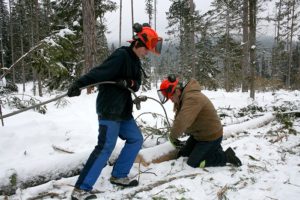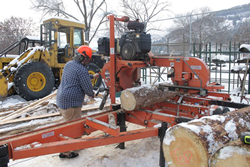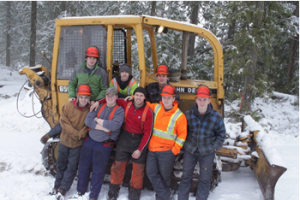There are just two high schools in British Columbia that manage their own woodlot and one of them is in the Shuswap. Charles Bloom Secondary in Lumby has run a forestry trade program since the 1970s and it was vastly improved in 2002 with the acquisition of a 600-hectare woodlot in the Trinity Valley. Every year, 16 grade 11 and 12 students are chosen from five high schools in the Vernon School District to participate in this outdoor, hands-on forestry skills program that runs from September to January.
The high school has teamed up with a professional forester and a career logger to deliver the innovative and very worthwhile program. Prior to going into the bush, all students are taught St. John First Aid to ensure safety. The students spend three days a week in the woodlot, operating and maintaining machinery, bucking logs, cutting firewood and learning skills. They do nearly every job, except falling the trees, which is done by a certified faller.
During their two days in the classroom and school shop, the students study Workman’s Compensation Board safety procedures, as well as furniture building design and techniques. Projects completed during the program in the school’s large, well-equipped shop include massive picnic tables, a miniature log cabin and a timber-framed gazebo that was set-up where there is a magnificent view of the valley below. The program’s new instructor, Martin Toombs, is also adding tree identification, knot-tying and possibly welding to this year’s curriculum.
One of the factors behind the success of the school’s forestry program is the strong connection it has with the local community. The local chainsaw dealer often provides contributions and contractors either donate used machinery or sell the equipment for very low prices. Community members also readily purchase the firewood cut by the students, who then use the money to purchase the gear they need for the program.
The final products, such as bed frames, tables and benches, either go home with the students or are donated to the community. Annual revenue from the logs sold to nearby sawmills such as Tolko and North Enderby Timber, averages $30,000, which goes back into the program for equipment and maintenance expenses.
Other Lumby students also benefit from the forestry program. In the spring, grade 7 students are enlisted to help plant trees in the woodlot. And then they return each year to view the growth of the seedlings and observe the transformation of the site from cleared land to a managed forest.
Graduates of the forestry program are using the skills and knowledge they acquired to help them find work or to further their training. For some of them, one of the major benefits is the increased level of confidence that they gain. And they often use the experience and the associated good references to help them advance in what can be a competitive workplace.
The success of the Lumby high school forestry program should serve as a model for all levels of government that are now looking at overhauling skills-training, due to the growing shortage of skilled workers. According to the advocacy group Canadian Manufacturers and Exporters, there will be an estimated 1.3 million skilled labour job vacancies by the year 2016. Already, foreign workers are coming to Canada to take jobs not being filled by Canadians.
For too long, high school students have been encouraged to focus on attending colleges and universities and as a result many are unable to find appropriate employment after they graduate. One solution would be for high schools to improve their curriculums to include more programs that encourage skills-training for all the well-paying jobs in the trades that need workers now and in the future.
POSTSCRIPT
The students that finish the forestry program may not necessarily go into a forestry job, but the experience of taking the course gives them a huge boost that helps them succeed in other trades as well. I think more programs like this one are needed in secondary schools so that students have an opportunity to participate in the real world and thus gain the skills and experiences they need to either further their education or move into careers at an earlier age. It would make far more sense for Canada to train students for careers in the trades instead of bringing in foreign workers.
You can learn more about the Charles Bloom Secondary School forestry program here www.sd22.bc.ca/forestry.html and there is a short video on this page as well.









